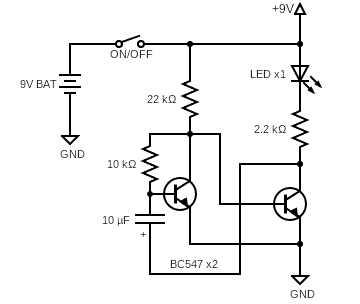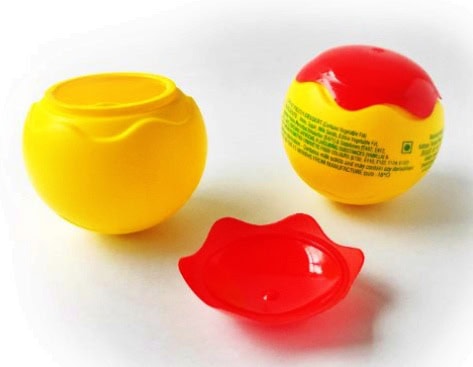Today we will see how to build a flashing float using a handful of commonly available inexpensive electronics components.
This is the circuit diagram of the flashing LED float…

List of components is shown below.
- 9V Battery x1 (https://data.energizer.com/pdfs/l522.pdf)
- On/Off Slide Switch x1
- 22KΩ ¼ W Resistor x1
- 2.2KΩ ¼ W Resistor x1
- 10KΩ ¼ W Resistor x1
- 10uF/25V Electrolytic Capacitor x1
- BC547 Transistor x2
- 5mm or 10mm LED x1
Something else about the circuit and the component values. This is in fact a classic nonlinear electronic oscillator circuit centered around a pair of bipolar junction transistors. The 10uF capacitor determines the flashing frequency. The 2.2KΩ resistor limits the operating current of the LED.
So let us get to work…
What do we need? Just a light source with a battery that lasts a long time, a lightweight housing that floats, is tight and carries the electronics. Just should not be that big.
This is what its breadboard prototype looks like. The quick test setup is equipped with a 5mm ultrabright Red LED.

Finally, making the flashing float is not as difficult as you may think. Get a plastic ball or ice cream packing ball from your collection (see below). Keep all the electronics inside it, including the battery. Close the ball and wipe aquarium sealant along the edge to make it watertight (remember to secure the slide switch on top of the ball).

Does it float?
Note, for something to float, it must have a specific gravity less than water. That is, if the density of the plastic ball (flashing float) is less than the density of water, the weight of the water displaced by the ball is more than the weight of the ball. Thus, by the principle of floatation the ball floats in water.
As a side note, Archimedes’ principle states that the upward buoyant force that is exerted on a body immersed in a fluid, whether fully or partially, is equal to the weight of the fluid that the body displaces.
Any object, totally or partially immersed in a fluid or liquid, is buoyed up by a force equal to the weight of the fluid displaced by the object.
Archimedes’ principle allows the buoyancy of any floating object partially or fully immersed in a fluid to be calculated.
The downward force on the object is simply its weight. The upward, or buoyant, force on the object is that stated by Archimedes’ principle above.
Thus, the net force on the object is the difference between the magnitudes of the buoyant force and its weight.
If this net force is positive, the object rises, if negative, the object sinks, and if zero, the object is neutrally buoyant – that is, it remains in place without either rising or sinking.
In simple words, Archimedes’ principle states that, when a body is partially or completely immersed in a fluid, it experiences an apparent loss in weight that is equal to the weight of the fluid displaced by the immersed part of the body.
In conclusion, there is so much you can do with this cool little circuit. While this particular project may not be helpful to you, it might be helpful to someone younger or less experienced than you. So, please take just a few seconds to share this on your favorite social media channel. Thanks for reading!



